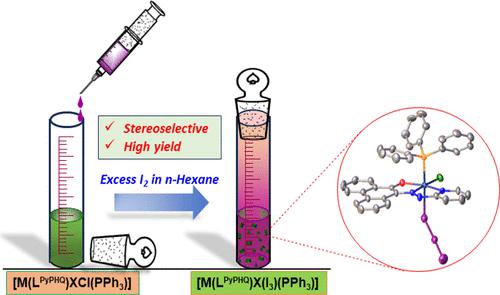当前位置:
X-MOL 学术
›
Cryst. Growth Des.
›
论文详情
Our official English website, www.x-mol.net, welcomes your feedback! (Note: you will need to create a separate account there.)
Halogen Bonding in Stereoselective Metal Chloride (M–Cl) Bond Activation and Transformation to Metal Triiodide (M–I3)
Crystal Growth & Design ( IF 3.8 ) Pub Date : 2024-03-26 , DOI: 10.1021/acs.cgd.4c00066 Soumitra Dinda 1 , Debashis Jana 2 , Rosa M. Gomila 3 , Antonio Frontera 4 , Subhadip Roy 5 , Sarat Chandra Patra 2 , Kausikisankar Pramanik 2 , Sanjib Ganguly 1
Crystal Growth & Design ( IF 3.8 ) Pub Date : 2024-03-26 , DOI: 10.1021/acs.cgd.4c00066 Soumitra Dinda 1 , Debashis Jana 2 , Rosa M. Gomila 3 , Antonio Frontera 4 , Subhadip Roy 5 , Sarat Chandra Patra 2 , Kausikisankar Pramanik 2 , Sanjib Ganguly 1
Affiliation

|
The isolation of isomeric complexes trans-[RuIILPyHPQ(CO)(PPh3)Cl] 2 and cis-[RuIILPyHPQ(CO)(PPh3)Cl] 3, (Cl and PPh3 are trans in 2 and they are cis in 3 respectively) as well as [RuIILPyHPQ(CO)(PPh3)2Cl] 4 and [RhIIILPyHPQ(PPh3)Cl2] 5 disclose the flexidentate nature of the multifunctional ligand, HLPyHPQ 2-pyridylhydrazinophenanthrenequinone, 1. These complexes are maneuvered as molecular templates for understanding the role of halogen bonds (XB) in M–Cl bond activation and subsequent cleavage processes. Both isomeric forms 2 and 3 furnish trans-[RuIILPyHPQ(CO)(PPh3)(I3)] 6 (where PPh3 and I3– in trans position) when they are treated separately with I2 in a hydrocarbon solvent. Nonetheless, complex 5 is converted to 7 upon similar treatment but 4 remains unreacted. Crystal structure of 7 revealed that it is composed of 62% trans-[RhIIILPyHPQ(PPh3)Cl(I3)] and 38% trans-[RhIIILPyHPQ(PPh3)Cl(ClI2)] (where PPh3 and I3–/ClI2– are trans). The I3–/ClI2– gets coordinated to metal centers exclusively in an end-on fashion in all cases. Since the valence state of metal centers remains unaltered in due course of the reaction, the emergence of M–I3/M–ClI2 from M–Cl in the absence of any reductant in solution is indicative of prior activation of M–Cl bond via the formation of Halogen Bond (XB) of type [M–Cl–I–I] in an intermediate step. The geometrical fluctuations around the coordination sphere during the transformation of cis-[RuIILPyHPQ(CO)(PPh3)Cl] 3 to trans-[RuIILPyHPQ(CO)(PPh3)(I3)] 6 is reminiscent of the active influence of XB, triggering the isomerization of 3 to 2 owing to steric encumbrance, before it is being converted to 6. Electrochemical behavior and optoelectronic properties of the complexes have been complimented by theoretical analysis and the structures were characterized by SCXRD. Repeated π-stacking motifs in the crystalline phase architecture of the complexes have been scrutinized using DFT calculations.
中文翻译:

立体选择性金属氯化物 (M–Cl) 键活化中的卤素键以及向金属三碘化物 (M–I3) 的转化
异构体配合物反式-[Ru II L PyHPQ (CO)(PPh 3 )Cl] 2和顺式-[Ru II L PyHPQ (CO)(PPh 3 )Cl] 3的分离,(Cl 和 PPh 3为反式2)并且它们在3中分别是顺式)以及[Ru II L PyHPQ (CO)(PPh 3 ) 2 Cl] 4和[Rh III L PyHPQ (PPh 3 )Cl 2 ] 5公开了多功能配体的挠齿性质, HL PyHPQ 2-吡啶肼菲醌,1。这些复合物被用作分子模板,用于了解卤素键 (XB) 在 M-Cl 键激活和随后的裂解过程中的作用。当分别用 I 2在烃中处理时,异构体形式2和3均提供反式-[Ru II L PyHPQ (CO)(PPh 3 )(I 3 )] 6(其中 PPh 3和 I 3 –处于反式位置)溶剂。尽管如此,经过类似处理,络合物5转化为7 ,但4仍未反应。7的晶体结构显示其由62%反式-[Rh III L PyHPQ (PPh 3 )Cl(I 3 )]和38%反式-[Rh III L PyHPQ (PPh 3 )Cl(ClI 2 )]组成(其中 PPh 3和 I 3 – /ClI 2 –是反式)。在所有情况下,I 3 – /ClI 2 –都以端接方式专门与金属中心协调。由于金属中心的价态在反应过程中保持不变,因此在溶液中不存在任何还原剂的情况下从 M-Cl 中出现 M-I 3 /M-ClI 2表明 M-Cl 键的预先激活通过在中间步骤中形成 [M–Cl–I–I] 类型的卤素键 (XB)。顺式-[Ru II L PyHPQ (CO)(PPh 3 )Cl] 3向反式-[Ru II L PyHPQ (CO)(PPh 3 )(I 3 )] 6转化过程中配位球周围的几何涨落为让人想起 XB 的积极影响,在转化为6之前,由于空间阻碍而引发3异构化为2。理论分析证实了配合物的电化学行为和光电性质,并通过 SCXRD 表征了结构。使用 DFT 计算仔细检查了复合物晶相结构中的重复 π 堆积图案。
更新日期:2024-03-26
中文翻译:

立体选择性金属氯化物 (M–Cl) 键活化中的卤素键以及向金属三碘化物 (M–I3) 的转化
异构体配合物反式-[Ru II L PyHPQ (CO)(PPh 3 )Cl] 2和顺式-[Ru II L PyHPQ (CO)(PPh 3 )Cl] 3的分离,(Cl 和 PPh 3为反式2)并且它们在3中分别是顺式)以及[Ru II L PyHPQ (CO)(PPh 3 ) 2 Cl] 4和[Rh III L PyHPQ (PPh 3 )Cl 2 ] 5公开了多功能配体的挠齿性质, HL PyHPQ 2-吡啶肼菲醌,1。这些复合物被用作分子模板,用于了解卤素键 (XB) 在 M-Cl 键激活和随后的裂解过程中的作用。当分别用 I 2在烃中处理时,异构体形式2和3均提供反式-[Ru II L PyHPQ (CO)(PPh 3 )(I 3 )] 6(其中 PPh 3和 I 3 –处于反式位置)溶剂。尽管如此,经过类似处理,络合物5转化为7 ,但4仍未反应。7的晶体结构显示其由62%反式-[Rh III L PyHPQ (PPh 3 )Cl(I 3 )]和38%反式-[Rh III L PyHPQ (PPh 3 )Cl(ClI 2 )]组成(其中 PPh 3和 I 3 – /ClI 2 –是反式)。在所有情况下,I 3 – /ClI 2 –都以端接方式专门与金属中心协调。由于金属中心的价态在反应过程中保持不变,因此在溶液中不存在任何还原剂的情况下从 M-Cl 中出现 M-I 3 /M-ClI 2表明 M-Cl 键的预先激活通过在中间步骤中形成 [M–Cl–I–I] 类型的卤素键 (XB)。顺式-[Ru II L PyHPQ (CO)(PPh 3 )Cl] 3向反式-[Ru II L PyHPQ (CO)(PPh 3 )(I 3 )] 6转化过程中配位球周围的几何涨落为让人想起 XB 的积极影响,在转化为6之前,由于空间阻碍而引发3异构化为2。理论分析证实了配合物的电化学行为和光电性质,并通过 SCXRD 表征了结构。使用 DFT 计算仔细检查了复合物晶相结构中的重复 π 堆积图案。



























 京公网安备 11010802027423号
京公网安备 11010802027423号